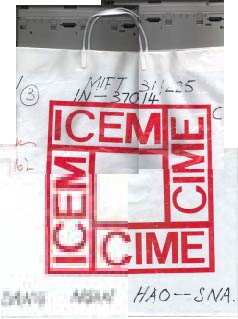

Although the United States has a long-standing tradition of accepting people fleeing oppression in other countries, many Americans were not in favor of admitting numerous Southeast Asian refugees. In fact, one public opinion poll taken when Saigon fell in 1975 showed only 36% of the respondents in favor of Vietnamese immigration, fearing loss of jobs and increased public spending. However, President Gerald Ford and other public figures, including people who had been opposed to the war in Vietnam, strongly supported the refugees. Congress allocated resettlement aid and passed the 1975 Indochina Migration and Refugee Act, which allowed the refugees to enter the United States under a special migration and "parole" status.
In order to avoid the formation of ethnic enclaves and to lessen the impact of large numbers of refugees in one geographic area, the government initially dispersed the refugees all over the country. Within a few years, however, a significant amount of secondary migration occurred, mainly to California and Texas, the two states that now have the largest Southeast Asian populations.
The resettlement effort reflected the work of voluntary agencies, individual citizens, and federal, state, and local governments, all working together to assist the new arrivals in adjusting to American society. Voluntary agencies (known as "volags") such as the United States Catholic Conference, the International Rescue Committee, and Church World Service arranged sponsorships for the refugees and took care of their initial needs upon arriving in the United States. Many church groups, corporations, and individuals became sponsors for refugee families, providing housing, food, and clothing until these families were able to live independently.
The Refugee Act of 1980 created the Office of Refugee Resettlement, which administers programs and services for refugees within the U.S. Individual states play a central role in the resettlement process and are required to have a plan for refugee assistance in order to receive federal funding. Similarly, certain federal programs such as targeted assistance grants are administered at the county level.
The refugees themselves have done much to further successful resettlement. Mutual assistance associations organized by previously resettled Southeast Asian refugees to help the newcomers have provided essential social, psychological, cultural, educational, and economic services.
27. Newsletter. United States Catholic Conference. August 1982. Donated by Dr. Van Le.
28. Refugees at Hamilton Air Force Base, Novato, California (Lao monk, Hmong man with water pipe, and Laotian hill tribe family). Three photographs, 1980-1981. Donated by Mitchell I. Bonner.


Hamilton was used as a rest stop for refugees from 1980-1982.
They landed at Travis Air Force Base or Oakland Airport and were taken
by bus to Hamilton, where they spent the night before leaving for their
final resettlement destination.
29. Profiles of Some Good Places for Cambodians to Live in the United States. Washington, D.C.: U.S. Office of Refugee Resettlement, 1989.

30. "Still coming." In: Los
Angeles Times, May 7, 1975. Halftone on newsprint. Donated
by Galen Beery.
31. A Profile of Vietnamese Re-Education
Camp Detainees in U.S.A. By Them K. Tran. Los Angeles:
United Vietnamese Community Council, 1992. Donated by Them K. Tran.
32. Capturing the Change: The Impact of Indochinese Refugees in Orange County: Challenges and Opportunities. By C. Beth Baldwin. Santa Ana, Calif.: Immigrant and Refugee Planning Center, 1982. Donated by Dr. Son Kim Vo.
33. Introduction to Cambodian Culture.
By C. Sun-Him.
Laos, Culturally Speaking. By Khamchong Luangpraseut.
Introduction to Vietnamese Culture, by Huynh Dinh Te.
San Diego: Multifunctional Service Center, San Diego State University,
1989. Donated by Dr. Huynh Dinh Te.
34. Proclamation, City of Irvine, California, November 15, 1990. Donated by the Refugee Forum of Orange County.

Official Commemoration of the Tenth Anniversary of the Refugee Act
of 1980.
35. Vietnam Business Directory. Garden Grove: Vietnamese Chamber of Commerce in Orange County, 1986. Donated by Giao Hoang.

36. Amerasian News. August
1992. Garden Grove: Saint Anselm's Immigrant and Refugee Community
Center. Donated by Peter Daniels.
St. Anselm's was one of sixty "cluster sites" designated to assist in the adjustment of Amerasians brought to the United States under the Amerasian Homecoming Act of 1988.
37. Newsletter (Trung Tam Dich Vu Cong Dong Nguoi Viet tai Orange County). Jan. 1980. Westminster: Vietnamese Service Center. Donated by Do Dinh Tuan.
First newsletter published by the Vietnamese Service Center, which became the Vietnamese Community of Orange County, Inc. in 1981.
38. Vietnamese woman in ao dai.
39. Vietnamese refugees arriving at
the Air Force base.
Hamilton Air Force Base, Novato, Calif. Photographs, 1981.
Donated by Mitchell I. Bonner.
40. ICEM plastic bag used by refugees to hold X-rays and documentation. 1979. Donated by Guire John Cleary.
ICEM is the Intergovernmental Commission for European Migration, which later became ICM, the Intergovernmental Commission for Migration. Each refugee carried such a bag.
41. "Estimated Southeast Asian Population, 1975-1991: ten states of major concentration." In: Refugee Resettlement Program: Report to the Congress, January 31, 1992. Washington, D.C.: U.S. Office of Refugee Resettlement, 1992.
 |
UCI Libraries Homepage
UCI Homepage |
https://www.lib.uci.edu/ sites/all/exhibits/seaexhibit/ Copyright 1999, University of California |
UCI Southeast Asian Archive P.O. Box 19557 Irvine, CA 92623-9557 (949) 824-4968 |







